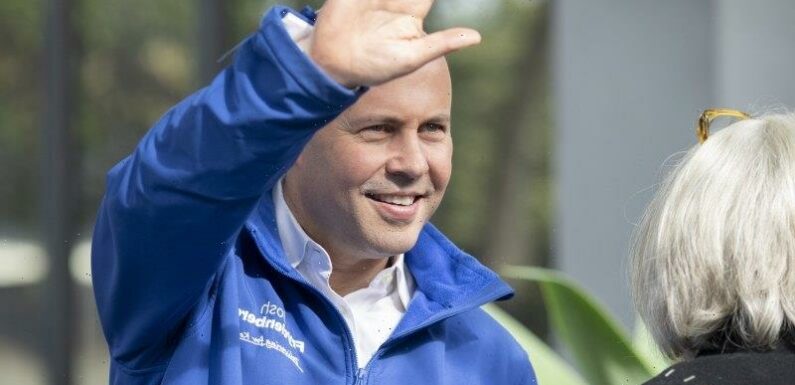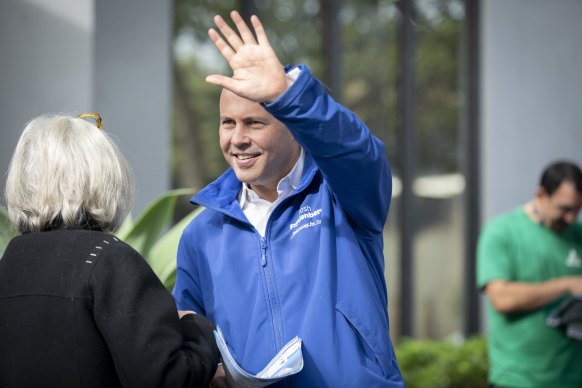
Ping! The messages were from Josh Frydenberg. Liberal MPs, political allies and friends were all on the receiving end. It was Friday, March 3, and the Goldman Sachs banker was plugged in. Ping: Frydenberg again. The recipients say his WhatsApp status barely changed from “online” all afternoon.
Animating the former treasurer – who saw himself as a future prime minister before losing his seat of Kooyong at the last election – was more than 200 pages of potential political dynamite.
Josh Frydenberg campaigning in Kooyong last year.Credit:Arsineh Houspian
His messages contained screenshots of excerpts of affidavits freshly released in the embarrassing legal fight between the woman who defeated him, independent Monique Ryan, and her former chief of staff Sally Rugg.
Frydenberg’s hawk-like interest in the Federal Court case – which he hopes will chip away at Ryan’s cleanskin image for months if a settlement cannot be reached before trial – isn’t necessarily a case of sour grapes. It also says a lot about his ambitions for Kooyong.
The day after Ryan was accused of being a hostile boss in court, Frydenberg published his first social media post at a Kooyong community event since the election. “It was terrific to see so many people out today,” he wrote after appearing at the Liberal Party stall at the Glenferrie Festival.
Even before the court case burst into public view on Australia Day eve, the 51-year-old was more likely than not to run again, according to about ten Liberal figures who speak with him who requested anonymity to speak frankly.
However, he was genuinely weighing up whether returning to Canberra was best for his young family. He was also waiting to see how the state of the economy and Ryan’s performance altered the likelihood of a second straight loss.
But following weeks of negative coverage of Ryan, Frydenberg’s thinking about the Kooyong contest has shifted according to close associates.
Ryan and Frydenberg both declined to comment, but Frydenberg’s associates say he has become more upbeat about winning the seat after hearing positive feedback from voters. In conversations, he is giving every indication he will run while being careful not to say so explicitly. Adding to his confidence is Ryan’s awkward response to Labor tax proposals that would hit voters in one of Australia’s wealthiest electorates.
But it will take a monumental effort to win back Kooyong, which stretches from Hawthorn to Balwyn in Melbourne’s inner-east (although there is a looming redistribution of electoral boundaries). The seat now has the highest number of voters under the age of 24 and a growing number of high-rise apartments occupied by renters – particularly in the sections of the electorate around Hawthorn closest to the CBD – who tend not to vote Liberal.
These changing demographics were harnessed by Ryan’s teal army, who rode a wave of dissatisfaction with the Morrison government’s policies on climate change, political integrity and women’s rights to win the seat of Liberal Party founder Robert Menzies that had never had a non-Liberal representative.
Over three elections, Frydenberg’s primary vote had slowly been eroded from nearly 60 per cent to 43 per cent. Ryan holds it with a 2.9 per cent margin after a 6.5 percentage point Liberal primary vote drop (smaller than those experienced by Liberals in other seats lost to teals).
Illustrating the difficulty Frydenberg would face, ABC election analyst Antony Green said only one independent MP in a metropolitan federal seat – Kerryn Phelps – had won a seat off a major party and lost at the next election (Phelps initially won the Sydney seat of Wentworth in a byelection).
An overriding question is whether voters in the seat will remember, or care, about the Rugg dispute when they vote some time next year or as late as September, 2025.
The pollster who worked with the Climate 200 vehicle that partly funded Ryan’s campaign, Kos Samaras, said his experience observing political blow-ups for decades as a Labor campaigner led him to believe the court dispute would have little effect.
Many voters would see the case as an unremarkable workplace dispute, he argued. More importantly, Samaras said demographic sands would continue to shift underneath Frydenberg, creating an even younger electorate.
“And there’s nothing the Libs are doing at the moment to talk to them,” he said.
But there is a growing view within the Liberal Party that Ryan is permanently damaged and one of her biggest assets, her image as a person of integrity who rises above the political fray, has been diminished.
Liberal Senator James Paterson, who lives in Kooyong and has been speaking to locals about Ryan, said he believed Ryan’s political stocks had fallen. Frydenberg, he noted, would “have a lot of value to add” if he ran again in Kooyong.
“Ryan spent her first month fighting for more taxpayer-funded staff for herself, voted for Labor’s union-friendly industrial relations changes, and has urged the government to break their election commitment on stage three tax cuts and superannuation taxes,” he said.
Frydenberg spoke at Kooyong Liberal branch AGM last Sunday, according to two sources present, but he avoided directly discussing his thinking on running again. Other senior Liberals – including former senator Rod Kemp, a Frydenberg ally who still runs the branch, and Victorian Opposition Leader John Pesutto – said at the meeting that Frydenberg should return, sources said.
Roy Morgan polling before the election showed Frydenberg was the preferred prime minister by a big margin. But a strong teal ground campaign damaged him and some Victorian Liberal figures argue Frydenberg created a false narrative that former prime minister Scott Morrison was solely to blame for losing. Frydenberg’s own polling showed his net favorability rating dropped from being significantly positive in late 2021 to only marginally positive before the May 2022 election.
Frydenberg’s closeness to Morrison – whom he lived with at the Lodge during a Melbourne lockdown – added weight to what his detractors argue is his overstated political judgement. For all Frydenberg’s energy and presentability, his opponents assert he is media-obsessed and point to billions of JobKeeper dollars that flowed to profitable businesses as a sign of his policy capacity.
“This is the problem with Josh: he doesn’t accept that people were sick of his smiling face. He allowed himself to be convinced this was all about Morrison. What he fails to realise is he’s not liked. He was treasurer and deputy leader. If that government was unpopular, so was he,” one Victorian Liberal said.
This sentiment, however, is shared by a relatively small section of the party. Frydenberg has the overwhelming support of federal MPs, powerbrokers and rank and file members who think he was a good treasurer.
Opposition Leader Peter Dutton said he “would love to have [Frydenberg] back as part of our team as the next member for Kooyong”.
“Josh has been a friend for over 20 years and I want him to run again.”
The Liberal Party’s ability to win back the state seat of Hawthorn – which is within Kooyong – and hold off teal challengers in both Hawthorn and Kew has shown Liberals the value of grassroots campaigning against community independents. According to teal sources, these state losses also worried some in Ryan’s camp.
Ryan’s fate will rest partly on her capacity to hold on to the votes of former Liberal voters, whom an Australian National University study found made up about 20 per cent of the teals’ support across Australia. Also key will be the more than 50 per cent of teal voters who previously voted Labor or Green, who might feel less urge to vote for an anti-Liberal independent without the presence of an unpopular Coalition government.
Liberals hope the increased focus on the deteriorating economy and sky-high prices will cause a portion of the former Liberal voters to come back into their pile. They plan to wedge Ryan on her positions on tax policies.
In her dozens of Facebook posts this year, Ryan has spoken about cost-of-living once. Instead, she has communicated with voters about youth justice, COVID-19, the Trove database and the Indigenous Voice to parliament.
Ryan – whose seat has the highest average superannuation balance in Australia – has declined to either support or oppose the government’s tax rise for people with more than $3 million in superannuation. She also abstained from voting last week when MPs were deciding whether to limit the payment of franking credits on shares.
“How would this affect you directly?” Ryan cautiously asked her constituents about the superannuation change.
Some of her teal allies, such as Goldstein’s Zoe Daniel and Wentworth’s Allegra Spender, have taken more unequivocal, and pragmatic, positions arguing against Labor’s proposals, which they have deemed “class war”.
It’s unclear if informed, well-off voters of Kooyong will be swayed by a Liberal Party campaign warning of Labor’s higher taxes. These sorts of attacks can often be more effective in rallying aspirational voters in the suburbs. Nevertheless, Ryan is in an invidious position as she balances her instincts to advocate for an equitable tax system while not offending her own wealthy voters.
A tweet by Rugg last month – which Ryan is using in court as evidence of Rugg’s unsuitability for the job – highlighted this conundrum. Tweeting a link to a story about teal MPs’ opposition to tax rises on wealthy superannuants, she wrote: “A progressive, equitable tax system for a sustainable budget and future-focussed economy! Oh, except keep tax breaks for the top 1% of income earners.”
It is signs of disloyalty like this that have drawn the ire of Ryan’s loyal teal army on their favoured platform, Twitter. Campaigner Brent Hodson recalled an anecdote in which Rugg was compared to former Abbott-era chief of staff Peta Credlin. Another teal volunteer labelled Rugg’s decision to board a flight with COVID-19 “spectacularly selfish”.
Should he run for preselection in Kooyong, Frydenberg will probably be joining Tim Wilson in Goldstein and Katie Allan in Higgins. Wilson has not confirmed his run but has prepared a voluminous research document exploring how to win back his bayside seat.
Allan, meanwhile, was slightly alarmed when she read a story in The Australian, exactly one month after the last election, saying Frydenberg could run in Higgins, the seat taking in Toorak that she lost to Labor.
It prompted Allan – who, like Ryan, is a highly credentialed and confident former paediatrician – to drive from Prahran, past the Kooyong Lawn Tennis Club, to Frydenberg’s Californian bungalow in Hawthorn. She informed Frydenberg she intended to run again in Higgins and asked his advice on how to win it back.
The message was clear: Higgins is Allan’s territory, and Frydenberg’s path to the Liberal leadership runs through Kooyong.
Cut through the noise of federal politics with news, views and expert analysis from Jacqueline Maley. Subscribers can sign up to our weekly Inside Politics newsletter here.
Most Viewed in Politics
From our partners
Source: Read Full Article
